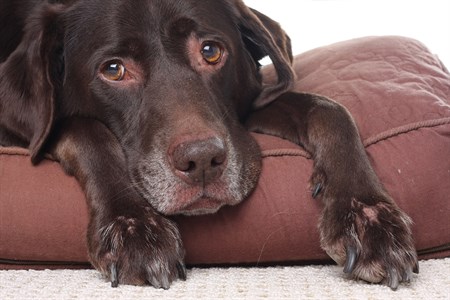A Bed for Fluffy and Fido
Just as we desire to curl up in bed after a long day at work, our pets enjoy a comfortable place to rest from an afternoon of guarding the house or chasing squirrels in the backyard. With so many types of elaborate bedding to choose from, selecting the right one for Fluffy and Fido can be a bit daunting. Here are some tips to make the bedding hunt a little easier.

The best bedding for your dog or cat is one tailored to their specific needs and preferences. First, observe how they prefer to sleep. Does Fido like to sprawl out on the floor, cuddle on the couch or rest on a big pillow? This can give you a good idea of what exactly they would enjoy in their own bedding. Next, factor in their age, size, and any specific health requirements they might have.
“Puppies and kittens cannot regulate their body temperature, so for them, additional heat support to roughly a temperature of 90 degrees Fahrenheit is necessary for the first couple weeks of life,” said Dr. Medora Pashmakova, a Clinical Assistant Professor in Emergency and Critical Care at the Texas A&M College of Veterinary Medicine & Biomedical Sciences. “If newborns are wet or placed next to cold objects (such as metal cages or concrete floors), in drafts, or in outdoor enclosures, they can lose considerable amounts of heat.” Because of this, all puppies and kittens should be kept indoors where the temperature can be controlled and they have access to additional heat if needed.
If your pet has an allergy to a particular material, by all means try to avoid it. “Beddings these days are made of many different materials: cotton, polyester, wool—so find what’s right for your pet and what allows for easy cleaning,” said Dr. Pashmakova. “Dogs and cats can have sensitive skin and airways, so using perfume and dye-free detergents can keep irritation to a minimum.” It is also recommended that if your pet has had or currently has a flea infestation, paying special attention to bedding and its appropriate care, such as bleaching or just replacing altogether, is important to prevent future infestations.
When selecting the perfect bed, you should also consider any medical conditions, such as arthritis, that your pet has. “Many manufacturers now make heated beds, which is particularly useful for older dogs and cats that have orthopedic diseases,” Pashmakova said. “Keeping their joints warm and on soft padding will make them a lot more comfortable in the winter months.” Alternatively, a simple plush bed with soft sides is usually more than adequate for the remainder of the year.
To help prevent your dog or cat from the catching diseases, washing Fluffy’s bed on a regular basis is recommended to keep the bed and surrounding environment clean and germ free. “The most important aspect of bedding is your ability to keep it clean and dry, which will help to keep your pet free of disease and more comfortable,” said Dr. Pashmakova.
With the weather becoming colder and the nights becoming longer, out wandering the streets is no place for a cat or dog. If you decide to take in a stray animal for a night, there are ways to make them as comfortable as possible without exerting too much effort. “You don’t need to go out and find anything special, sometimes a cardboard box lined with towels can be perfectly comfortable,” said Dr. Pashmakova. “Both can be thrown away once the pet is no longer in your possession to prevent the transmission of disease or parasites that may have been on the homeless pet.” Pashmakova explains that the space for the animal doesn’t need to be very large, just enough to provide them with enough room to sit, lie down, and turn around comfortably.
If Fido is an outdoor-only dog, his bed requirements might be a bit more particular. “Outdoor bedding should include a shelter and non-porous bed that can be easily cleaned,” said Dr. Pashmakova. “Warm and dry bedding should be provided in the winter, and cool shade and plenty of water in the summer.” However, your pet really should not be left outside without shelter in extreme weather conditions. If in doubt, always bring your pet inside. “A good rule of thumb is, ‘If it’s uncomfortable for you, it’s probably even more uncomfortable for your dog or cat,’” said Dr. Pashmakova.
Taking these tips into consideration will undoubtedly help you find the perfect snoozing spot for Fido and Fluffy. Whether it’s a plush, heated bed or simply a cardboard box lined with old blankets, just remember that they don’t require elaborate, expensive furnishings to be happy; all they really need is you.
Pet Talk is a service of the College of Veterinary Medicine & Biomedical Sciences, Texas A&M University. Stories can be viewed on the Web at vetmed.tamu.edu/news/pet-talk. Suggestions for future topics may be directed to editor@cvm.tamu.edu.


